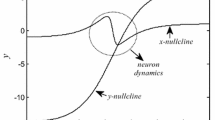Abstract
The paper presents a VLSI approach to approximate thereal-time dynamics of a neuron model inspired from the classicalmodel of Hodgkin and Huxley, in which analog inputs and outputsare represented by short spikes. Both the transient and the steady-statebehaviours of these circuits depend only on process-independentlocal ratios, thus enabling single or multiple-chip VLSI implementationsof very large analog neural networks in which parallelism, asynchronyand temporal interactions are kept as important neural processingfeatures. Measurements on an integrated CMOS prototype confirmexperimentally the expected electrical and temporal behavioursof the proposed neural circuits and illustrate some outstandingfunctional features of the neural model: spike-mediated modulationof the neural activity, self-regulation of the total activityin neural groups, and emulation of temporal interaction mechanismswith well controlled time constants at different scales.
Similar content being viewed by others
References
F. Faggin and C. A. Mead, “VLSI implementation of neural networks,” in An Introduction to Neural and Electronic Networks, Academic Press, pp. 275–292, 1990.
C. A. Mead, Analog VLSI and Neural Systems. Addison Wesley: Reading MA, 1989.
A. Andreou and K. Boahen, “A 48'000 pixel, 590'000 transistor silicon retina in current-mode subthreshold CMOS,” in Proc. 37th Midwest Symposium on Circuit and Systems, Lafayette, Louisiana, 1994, pp. 97–102.
T. Delbruck, “Silicon retina with correlation-based velocity-tuned pixels.” IEEE Tran. on Neural Networks, pp. 529–541, May 1993.
J. Lazzaro, J. Wawrzynck, M. Mahowald, M. Sivilotti and D. Gillespie, “Silicon auditory processors as computer peripherals.” IEEE Trans. on Neural Networks 4(3), pp. 523–528, 1993.
R. Lyon and C. A. Mead, “An analog electronic cochlea.” IEEE Tran. Accoust., Speech, Signal Processing 36, pp. 1119–1134, 1988
L. Watts et al., “Improved implementation of silicon cochlea.” IEEE JSSC SC-27, pp. 692–700, May 1992.
F. A. van Schaik et al., “Improved silicon cochlea using compatible lateral bipolar transistors,” in Neural Information Processing Systems 8, (D. S. Touretzky et al., eds.), MIT Press, 1996.
A. Mortara, A. E. Vittoz, Ph. Venier, “A communication scheme for analog VLSI perceptive systems.” IEEE Journal of Solid State Circuits 30(6), pp. 660–669, June 1995.
K. Boahen, “Retinomorphic Vision Systems,” in Proc. of MicroNeuro '96, Lausanne, Switzerland, 1996, pp. 2–14.
M. Chevroulet et al., “A battery operated optical spot intensity Measurement system.” ISSCC Digest of Technical Papers, pp. 154–155, Feb., 1995.
P. Venier et al., “Analog CMOS photosensitive array for solar illumination monitoring.” ISSCC Digest of Technical Papers, pp. 96–97, Feb., 1996.
X. Arreguit et al., “A CMOS motion detector system for pointing devices.” ISSCC Digest of Technical Papers, pp. 98–99, Feb., 1996.
M. Mahowald, “VLSI analogs of neural visual processing: A synthesis of form and function.” Ph.D. Dissertation. California Institute of Technology. 1992.
T. K. Horiuchi and C. Koch, “Analog VLSI circuits for visual motion-based adaptation of post-saccadic drift,” in Proc. of MicroNeuro '96, Lausanne, Switzerland, 1996, pp. 60–66.
G. Indiveri, J. Kramer and C. Koch, “System implementations of analog VLSI velocity sensors,” in Proc. of MicroNeuro '96, Lausanne, Switzerland, 1996, pp. 15–22.
A. Mortara and E. A. Vittoz, “A communication architecture tailored for analog VLSI artificial neural networks: Intrinsic performance and limitations.” IEEE Trans. on Neural Networks 5(5), May 1994.
A. L. Hodgkin and A. F. Huxley, “A quantitative description of membrane current and its application to conduction and excitation in nerve.” Journal of Physiology 117, pp. 500–544. 1952.
S. Grossberg, “Nonlinear neural networks: Principles, mechanisms, and architectures.” Neural Networks 1, pp. 17–61, 1988.
F. J. Pelayo, E. Ros, P. Martin-Smith, F. J. Fernández, A. Prieto, “A VLSI approach to the implementation of additive and shunting neural networks,” in Proc. of the IWANN'95, Torremolinos, Spain, 1995, pp. 728–735.
D. A. Fay and A. M. Waxmam, “Real-time early vision neurocomputing,” Proc. of the IEEE IJCNN'91, pp. 1621–1626, 1991.
X. Arreguit, E. A. Vittoz, F. A. van Schaik and A. Mortara, “Analog implementation of low-level vision systems,” in Proc. of the ECCTD'93, Davos, Aug. 30–Sept. 3, 1993.
Author information
Authors and Affiliations
Rights and permissions
About this article
Cite this article
Pelayo, F.J., Ros, E., Arreguit, X. et al. VLSI Implementation of a Neural Model Using Spikes. Analog Integrated Circuits and Signal Processing 13, 111–121 (1997). https://doi.org/10.1023/A:1008240229616
Issue Date:
DOI: https://doi.org/10.1023/A:1008240229616




